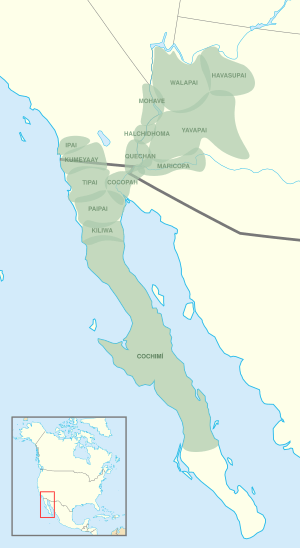Yuman–Cochimí languages facts for kids
Quick facts for kids Yuman–Cochimí |
|
|---|---|
| Yuman | |
| Geographic distribution: |
Colorado River basin and Baja California |
| Linguistic classification: | Hokan ?
|
| Subdivisions: |
Cochimí †
Kiliwa
Delta–California
River
Pai
|
 Pre-contact distribution of Yuman–Cochimí languages
|
|
The Yuman–Cochimí languages are a family of languages spoken in Baja California, northern Sonora, southern California, and western Arizona. Cochimí is no longer spoken as of the late 18th century, and most other Yuman languages are threatened.
Classification
There are approximately a dozen Yuman languages. The dormant Cochimí, attested from the 18th century, was identified after the rest of the family had been established, and was found to be more divergent. The resulting family was therefore called Yuman–Cochimí, with Yuman being the extra-Cochimí languages.
- Cochimí † (Northern Cochimí and Southern Cochimí may have been distinct languages)
- Kiliwa
- Core Yuman
- Delta–California Yuman
- River Yuman
- Pai
- Yavapai
- Havasupai-Hualapai (a.k.a. Northern Yuman)
- Hualapai dialect (a.k.a. Walapai)
- Havasupai dialect
- Paipai (a.k.a. Akwa'ala; possibly distinct from the Upland Yuman language only at the dialect level)
Cochimí is now dormant. Cucapá is the Spanish name for the Cocopa. Diegueño is the Spanish name for Ipai–Kumeyaay–Tipai, now often referred to collectively as Kumeyaay. Upland Yuman consists of several mutually intelligible dialects spoken by the politically distinct Yavapai, Hualapai, and Havasupai.
Proto-language
| Proto-Yuman | |
|---|---|
| Reconstruction of | Yuman languages |
| Lower-order reconstructions |
|
Urheimat
Mauricio Mixco of the University of Utah points to a relative lack of reconstructable Proto-Yuman terms for aquatic phenomena as evidence against a coastal, lacustrine, or riverine Urheimat.
Reconstruction
Proto-Yuman reconstructions by Mixco (1978):
-
gloss Proto-Yuman be *wi/*yu be located (sg) *wa belly *pxa; *p-xa big *tay bird *č-sa body hair *mi(ʔ) bone *ak breasts *ñ-maːy cat *-mi(ʔ) causative *x- chief man *-pa/*(ma) chief, lord *-pa/*ma cold *x-čur cry *mi(ʔ) dance *-ma(ʔ) daughter *p-čay die *pi die (sg) *pi do *wi/uːy do; make *wi/*uy dog *(č)-xat dove *k-wi(ʔ) drink *(č)-si; *si ? ear *ṣma(k)l ~ *ṣmal(k) earth, place *ʔ-mat eat (hard food) *č-aw eat (soft food) *ma extinguish *spa eye *yu(w) face *yu(w) (p)-xu fall *-nal father *n-ʔay; *-ta; *-ku ? feather *-waR fire *ʔ-ʔa(ː)w give *wi; *ʔi he *ña/*ya- head *ʔi(y) hear *kʷi(ː) heaven, sky *ʔ-ma(ʔ)y horn *kʷa ? hot *paR house *ʔ-wa(ʔ) husband *miːy imperative prefix *k- irrealis *-x(a) kill *pi leaf *ṣmak; *smaR lie (be prone) *yak locative *wa-l locative (illative) *-l locative (thither) *-m man, male *-miː(y); *maː(y) man, person *-pa/*ma mother *-tay; *-siy mountain lion *-miʔ tay mountain sheep *ʔ-mu(w) mouth *(y-)a name *maR navel *-pu neck/nape *iː-(m)puk ? non-present aspect *t nose *(p-)xu object, plural *pa object, unspec. (anim.) *ñ- perceive *kʷi possessive prefix (inal.) *ñ prefixes (trans.) *-, *m, *Ø priest *maː(y) pronominal prefixes (stative) *ñ, *m-, *w- pronominal subject *ʔ-, *m-, *Ø rabbit *pxar reed *xta relative pronoun *ña-/*ya relativizer *kʷ- salt *-ʔiR (< *s-ʔiR) say *ʔi shaman *-maː(y) sit *waː skunk *-xʷiw sleep *ṣma son (w.s.) *s-ʔaːw ? star *xmṣi subject suffix *-č; *-m sun, day *paR that *-ña/*-ya there *ña/*ya thing, something *ʔ-č third person *ña-/*ya this *p-u thorn *ʔ-ta(ː)t three *x-muk to blow *p-č/sul tongue *ʔimpal; *(y)pal; *-paR two *x-wak water *-xa(ʔ); *si we *ña-p wife *ku/*ki wing *waR woman *ki/*ku; *siñʔak word *maR yes *xaː
See also
 In Spanish: Lenguas yumano-cochimíes para niños
In Spanish: Lenguas yumano-cochimíes para niños

